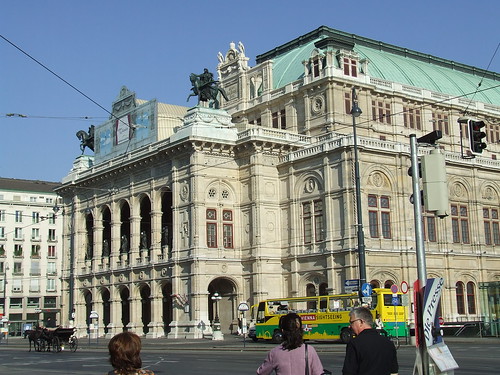Knowing the Vienna Opera
It was the first building that led to the Ring in Vienna, an urban whim of Emperor Franz Joseph I made up a grand boulevard five miles long that links the center of the Austrian capital and surrounds the old town. Its foundation stone was, therefore, the Staatsoper, or State Opera. Today cites this colossal structure is undisputed for the millions of tourists who come to the Central European capital and is regarded by audiophiles the world as a center of the opera more relevant, however almost two hundred years ago, when opened, was reviled and criticized by the public.

Photography by ChrisYunker
A controversial opera in its infancy:
The truth is that its construction did not start off right. Once foundations and structure was planted, the Viennese authorities decided to level the streets, which raised one meter above the ground and the feeling that the opera was sunk. No wonder that some of the descriptions that the press and authorities granted to the building were of «elephant indigestion» or «partially buried box» when in 1868 he inaugurated the work conceived by the architects Eduard van der Null and August Sicard von Sicardsburg.
In their minds was born neo renancentista that rose above the old opera house of the court. Its mission was to relay the Burgtheater since time of Empress Maria Teresa was the operatic center of Austria and the Viennese stage where strove to fuel the work of one of its most famous sons: Wolfgang Amadeus Mozart. Designed for this purpose a set of four large high altitudes in the central body (which houses the auditorium which currently has a capacity of over 2,200 people) and two in the outer galleries, full of references to Greco-Roman tradition and Renaissance (arches, friezes and pillars) pigeonholed this monumental set in the neo Renaissance.

Photography by bsdfm
According to critics, all this effort was not enough to overshadow the new building which is then considered the major reference of the opera: the building Garnier in Paris and La Scala in Milan. Such were the criticisms that none of its two creators came to hear a single note in it as the first, Van der Null, committed suicide and the second, Von Sicardsburg, died a month later by a fulminating heart attack.
The consolidation of a great opera:
Paradoxically, the tragedy and the bad reputation that was built around this building would be soon forgotten, as the first notes of Mozart’s Don Juan rang their boards a May 25, 1869. The acoustic quality of the central space silenced the gossips in fact, its brilliance and sharpness back after the damage suffered by aerial bombardment during the Second World War was the obsession of those who undertook to rebuild the stage and auditorium years later.
The war ended in a devastating fire that swept not only the decoration and interior of the theater but destroyed the huge amount of costumes, props and scenery that over the years and releases had been conserving and reusing. The priority was to return to the room acoustics and stage their original image. Thus, the room was covered timber, keeping the original colors (red, ivory and gold) but giving it a new more modern, and eliminating some of the columns on the fourth floor to gain visibility.

Photography by Ethan Prater
The revival, again, was a success: November 5, 1955 with representation of Beethoven Fidelio under the baton of Karl Böhm. Thus, the building was note for note, release after release, forging his name and value into what is today: one of the greatest cultural centers of the world.
The Vienna State Opera, one of the houses of culture in Europe!
Leave a Reply
You must be logged in to post a comment.
Recent Comments